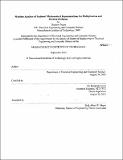Machine analysis of students' mathematical representations for multiplication and division problems
Author(s)
Peairs, Matthew (Matthew S.)
DownloadFull printable version (3.331Mb)
Other Contributors
Massachusetts Institute of Technology. Department of Electrical Engineering and Computer Science.
Advisor
Kimberle Koile.
Terms of use
Metadata
Show full item recordAbstract
This project extends Classroom Learning Partner classroom interaction software to include a semantic interpretation component. This semantic interpretation, combined with existing syntactic interpretation, enables the software to tag and group student work using knowledge of the math used in both creating and solving problems. The analysis is being prototyped using student work in grades 4 and 5, with focus on multiplication and division. First, during the authoring step, the notebook author gives each page a "page definition" that encapsulates the mathematical problem presented on that page. For a multiplication or division problem, this involves setting the three numbers connected by the product relation (e.g., 6 * 3 = 18), marking which of those numbers are given by the problem or otherwise unknown, and selecting an overall context for the problem, such as equal groups or area. Then, once students have submitted their work, the analysis component takes the raw output of the syntactic interpretation step and relates it back to the mathematical content of the page to assign each student's work a set of automatically generated tags. These tags address the correctness of a student's methods and results, as well as highlighting different problem-solving strategies that students might have used to arrive at the same answer. Finally, the teacher can sort student submissions by these various tags to quickly find noteworthy or contrasting examples to present to the class.
Description
Thesis: M. Eng., Massachusetts Institute of Technology, Department of Electrical Engineering and Computer Science, 2013. Cataloged from PDF version of thesis. Includes bibliographical references (page 35).
Date issued
2013Department
Massachusetts Institute of Technology. Department of Electrical Engineering and Computer SciencePublisher
Massachusetts Institute of Technology
Keywords
Electrical Engineering and Computer Science.